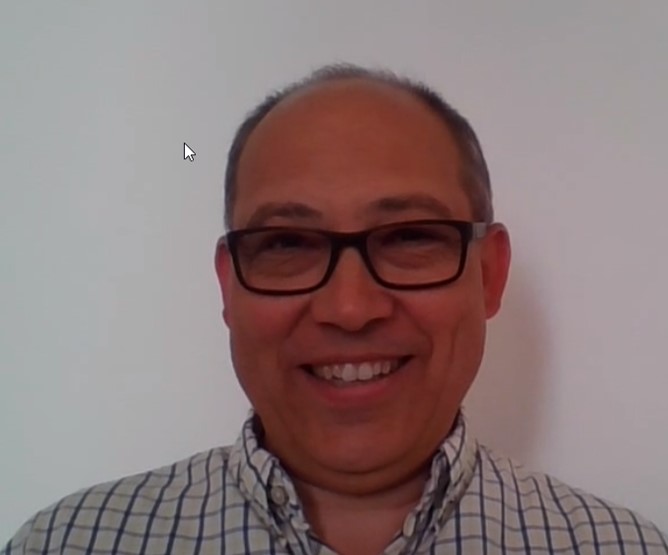Shawnna Sumaoang: Hi, and welcome to the Sales Enablement PRO podcast. I am Shawnna Sumaoang. Sales enablement is a constantly evolving space and we’re here to help professionals stay up to date on the latest trends and best practices so that they can be more effective in their jobs.
Today, I’m excited to have Paul-Olivier join us. Paul-Olivier, I’d love for you to introduce yourself, your role, and your organization to our audience.
Paul-Olivier Raynaud-Lacroze: Thanks, Shawnna. I’m Paul-Olivier. I’m French, like the accent probably betrays, and I am working for a Swiss company, dormakaba. We are specializing in secure access to buildings and all the hardware and software which closes or opens doors. I am the senior vice president for human resources and sales enablement for the Europe, Middle East, and Africa region.
SS: Well, I’m extremely excited that you’re here to talk to us today. As you mentioned in your introduction, you have a unique position as you oversee both human resources and sales enablement for your organization. I’d love to understand from your perspective, what does the intersection between HR and enablement look like and how do they complement each other?
PR: For me, sales enablement at it’s heart is around cultural change, changing the mindset of our sales organization. We make everything, culturally and also from the process point of view, perfect for the sales organization to be efficient, to be able to sell better, to sell more products to our customers. In the end, we revolve around the people, having the right people with the right competencies in place, having the right organizational structure. Onboarding is important and training on soft skills and the product.
A lot is actually stuff that I do for other parts of the organization. But I was put in charge the sales enablement function also a year ago, because in a sense, for some strange reason, it was one part of the organization which was forgotten. I’m part of the executive team of EMEA, and I could see that as a good nugget we had to tackle. In a sense, I was pushing for a while to have this function more prominent, or at least say it is a function, but more prominently presented in the executive team. We don’t have any chief sales officer or something like that. Because I’ve pushed too hard probably, it was created and then it was given to me.
So, there are a lot of similarities between what I did before in HR, but there are a lot of specificities. I had the luck that very early on, I could hire internally one of our most senior sales directors who can complement myself very well because he’s been doing the sales role for many years. I think we complement each other extremely well. He brings the credibility, the huge knowledge he has, and hopefully I can bring some of my change management and training abilities and experience.
SS: Absolutely. Now, how does it sales enablement help you to achieve some of your goals on the human resources side?
PR: For me, honestly, it’s not so much of a HR leader. I see more that sales enablement helps me to achieve my goals as one of the members of the executive team of the EMEA region. I think that we didn’t equip our salespeople with the right tools, the right training, the right processes. In a sense, we were not able sometimes to achieve some of our strategic objectives and, of course, related to the customer, sales revenue, etc. I see myself much more as a business leader who has by chance an HR hat, and I just complemented that with another hat now, which is the sales enablement hat. In the end, everything we do in the area of sales enablement is for me to help our EMEA teams and executive team to achieve our common goals. That’s more how I see it. From an HR point of view, the sales teams or salespeople are very important, like any other team, but I think I put myself more as an executive leader, more than as a pure HR leader when I started to push a lot for sales enablement to have a place at the table.
SS: I love that, I think you’re absolutely right. I think sales enablement is strategically positioned to help the entire business, especially the executive team. Now, you also have experienced, as you mentioned, leading sales transformation initiatives such as helping your organization navigate a merger. From your perspective, what are some key things to consider as you build a strategy for a transformation initiative to ensure that it’s successful?
PR: First of all, you need a vision for where you want to go. We started early on in our sales enablement journey and in collaboration with a business, with alignment with my peers, my colleagues in the management team, a lot of discussion and interviews. We created what we call the sales enablement manifesto. It was just two PowerPoint pages where we established, what was our vision and where we are going to work and where we are not going to work. We started by doing the vision and then of course, starting to communicate a lot, you can never communicate enough.
We are in a process where we are constantly aligning where we are with the executive team, but also the country managers, some of the big sales directors, just to make sure that they know where we are going. Of course, we are taking that feedback into account as long as we are making progress in the journey. For instance, we have completely revamped the way we have described our sales operating model, the way we have our sales channels. We have redefined a lot of things, which were probably in some heads and parts in some different PowerPoint presentations, but there were always some differences. It’s really to work together with the business to make that coherent and then with a lot of communication and making sure that it is truly understood by the people, it’s bought in.
It’s only when you have achieved that level that you can start going a bit further down the journey. In my company, we are quite decentralized. If you don’t have these constant alignment and discussion it won’t work if you just come from the top-down. If I use my senior VP title, it can work, but it won’t be super long lasting or it won’t be super motivating.
We’ll do it in a much more collaborative way.
SS: On the topic of alignment, aligning with stakeholders on goals is critical for transformation initiatives, as you mentioned. What are some best practices for securing stakeholder buy-in for your initiatives?
PR: It’s really understanding what the priorities of the important stakeholders are and when you understand them, it’s to see how when we are doing the sales enablement initiative or any other initiative, how we can help the key stakeholders achieve their own priorities. For most of my colleagues, they have a strong sales priority in their target. It’s clearly seen then how we can help them achieve their own priorities and overcome their own challenges. It’s a lot of discussion, understanding, using empathy, having a lot of business acumen, because we’re talking about customers, we’re talking about sales, so we need to understand sales.
You need to understand PLL and revenue and all of that. It’s really bridging the gap between what we want to do, what the users for it are, and making sure that they are aligned. Basically, it’s making sure that my colleagues understand that if we work together, they have a bigger chance to succeed, and we do as well. So, it’s really a collaborative effort. It takes a lot of communication, a lot of discussion, empathy, business acumen, and making sure that it all comes into one place at the end.
SS: Absolutely. You mentioned, as well, this notion of change management. For transformation to happen people need to be motivated to change. What are some of your best practices for, for persuading and motivating people to adopt new approaches?
PR: If I focus on what we’re doing at the moment in sales enablement, I think the main behavior that we have chosen is role modeling. For instance, we have established quite early on in our back in October last year, so still quite recent, a weekly call between my boss, the president of EMEA, and the five regional VPs. We have cut our EMEA zone into five regions, and every week we have a call with the president, myself and my deputy in sales enablement, and the five heads of the regions on key metrics. We are looking at pipeline, forecast for the week, forecast for the month, etc. We have started this cadence because we said to start changing the mindset to make sales enablement really part of the business, we needed to instill this sense of rhythm and rigor.
We have a weekly rhythm where it starts at the top, and now is being cascaded from the regional heads to the country heads from the country heads to their sales directors, sales managers, and salespeople. People don’t believe that we will sustain because we’re all busy, we have big calendars. But still every week now for the last five or six months, we have these regular calls. I must say that everyone is enjoying them. It’s not like punishment, it’s not asking why you lost this contract or this opportunity. It’s really just to have a lot of discussion about customers, about opportunities, what we can do to win these opportunities. It is creating a lot of talks about sales matters, which I think a lot of my colleagues are super happy with because they are salespeople at heart.
At the same time, it’s bringing this rhythm and rigor, which is a phrase we love to use, because people see that it’s not going away, it’s really being cascaded now. In a sense that is a push way, we have really started from the top and role modeling what we expect each level of the organization to do around sales matters or sales topics. At the same time, we also have a more pulling effect where we are understanding, talking with a business about what they need, where they would like us to create or what best practices they would like us to establish. It’s constantly pulling different levers and having a pushing and a pulling effect together. By doing this, we think that we can change little by little behavior because it’s coherent from the top to the lowest levels of the hierarchy. Because we’re working on topics which are important for the business, when a change needs to happen, people just are ready in their mind to change because they see that it is something they wanted also.
SS: I love that, rhythm and rigor. I think that’s fantastic. How would you go about measuring the business impact of your sales enablement efforts?
PR: We are still early in our journey. We started probably a year ago and of course at the beginning it was more establishing what was our vision and what we were supposed to do.
We are still early in the journey. Now, we have the typical metrics such as sales revenue, revenue by product line, revenue by sales channel, so we hope to see an increase over the years.
Now, it’s not only through sales enablement that that things may improve. We would like also to measure things which are a bit more specific. At the moment, one key metric we have in mind is simple one, we just want to measure year-over-year, from 2020 and measuring then 2021, 2022, etc., the proportion of salespeople who will have achieved one hundred percent or more of their targets. We assume that the targets have been fairly distributed and fairly established, and just how many people have indeed met or achieved those targets in 2020. So, we look at 2019 before we started anything, 2020 when we are getting on our feet, and 2021 and so forth where we probably will get more and more mature. That’s one specific metric that we never measured before, at least on the EMEA level that we are going to put in place.
The second one specific to our sales enablement initiative is just looking at what we call the conversion rate. We know from the number of opportunities which come our way, how many can we convert into others? Again, it’s a relatively simple measure which is not always tracked or perhaps tracked in a slightly different manner. We are going to clarify how it should be measured so that it can be comparable year over year, country to country. These two metrics, how many salespeople can achieve 1% or more of their targets and what is our conversion rate, will be the two main metrics we are going to follow for the moment. Perhaps in the few years we could be more sophisticated, but we are still early. We are going to focus on these two first.
SS: That’s fantastic. Thank you so much for joining us today. I really did enjoy learning from you. To our audience, thanks for listening. For more insights, tips, and expertise from sales enablement leaders, visit salesenablement.pro. If there’s something you’d like to share or a topic you’d like to learn more about, please let us know. We’d love to hear from you.






